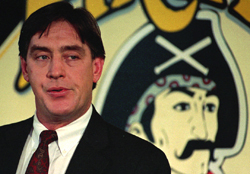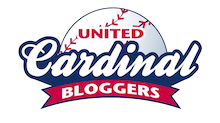(Updated May 26, 2020)
Looking to build on a reputation as a keen talent evaluator and decision-maker, Ted Simmons left a front-office job with the Cardinals for an executive position with a National League division rival.
 On Feb. 5, 1992, Simmons, 42, resigned as Cardinals director of player development and accepted an offer to become general manager of the Pirates.
On Feb. 5, 1992, Simmons, 42, resigned as Cardinals director of player development and accepted an offer to become general manager of the Pirates.
Emerging from a field of finalists that included Walt Jocketty, Simmons got the job because of the work he had done in improving the Cardinals farm system and because of his connections with Pirates president Mark Sauer.
Simmons’ rise was derailed, however, when, 16 months after becoming general manager, he suffered a heart attack and resigned.
Talent show
Elected to the Baseball Hall of Fame in December 2019, Simmons, a catcher, played 13 seasons (1968-80) for St. Louis, batting .298 and producing 1,704 hits and 929 RBI in 1,564 games.
In 1988, after Simmons finished his playing career with the Braves, he rejoined the Cardinals as head of their minor-league system.
Ray Lankford, Bernard Gilkey and Todd Zeile were among the prospects who developed into Cardinals players during Simmons’ tenure, enabling St. Louis to replace Willie McGee, Vince Coleman and Terry Pendleton.
Donovan Osborne, John Mabry and Dmitri Young were drafted by the Cardinals while Simmons was farm director.
Sauer, an Anheuser-Busch executive, joined the Cardinals as deputy chief operating officer and learned the baseball operation from Simmons.
Sauer was promoted to Cardinals executive vice president and chief operating officer in 1990. He left in October 1991 to become president and chief executive officer of the Pirates.
Search for success
Three months after he arrived in Pittsburgh, Sauer fired general manager Larry Doughty. Though the Pirates had won division titles in 1990 and 1991, Sauer was dissatisfied with the quality of the farm system under Doughty.
In his search for a general manager, Sauer identified five finalists. In addition to Simmons, they were:
_ Cam Bonifay, Pirates assistant general manager.
_ Bill Lajoie, former Tigers general manager.
_ Murray Cook, former general manager of the Yankees, Reds and Expos.
_ Walt Jocketty, director of baseball administration for the Athletics.
Simmons interviewed with Sauer in late January 1992. Simmons told Dan O’Neill of the St. Louis Post-Dispatch the session was “thorough, intense and in-depth.”
Eliminating Jocketty (who two years later would become general manager of the Cardinals) and Cook, Sauer pared the list to Simmons, Lajoie and Bonifay.
Lajoie, a scout with the Braves, was the preferred choice of Pirates manager Jim Leyland. When he was scouting director of the Tigers, Lajoie was a mentor to Leyland, who had been a player and manager in Detroit’s farm system.
Simmons told the Post-Dispatch he thought Bonifay would get the job.
Earned reward
Simmons was in a meeting when Cardinals chief executive officer Stuart Meyer came in and told him to expect a call from Sauer. A short while later, Sauer asked Simmons to be general manager.
Sauer described Simmons as “an outstanding evaluator of young talent” and “a good communicator.”
Asked whether their friendship was a factor in hiring Simmons, Sauer told the Pittsburgh Press, “My experience with Ted gives me a comfort level and confidence in what he can do, but this was not an issue of friendship. What I think made Ted the best choice was his demonstration of skills in the area of developing players in St. Louis.”
Said Simmons: “There’s no question Mark and I are friends, but there is also no question that during the time I was with Mark in St. Louis he was my boss … If I thought I stood here as general manager of the Pirates because I was Mark’s friend, No. 1, I would be embarrassed; No. 2, I would be ashamed.”
Simmons departed the Cardinals with the respect of general manager Dal Maxvill and manager Joe Torre.
“I’m extremely happy for him,” said Maxvill. “We had a great relationship. He was very loyal to me and to the organization. You couldn’t ask for better than Teddy.”
Said Torre: “He never does anything halfway.”
Pressure in Pittsburgh
Dedication and drive were qualities that helped Simmons get the job. Those attributes could become negatives, though, if not kept in check.
In their praise of Simmons, Maxvill and Sauer unintentionally foreshadowed trouble.
“His skin will have to be thick,” Maxvill said. “You can’t get too excited or too upset … You have to not let things bother you and just try to do the best you can and the best for the ballclub. I think he knows that.”
Said Sauer: “He’s very consumed with baseball. He lives and breathes baseball on many different layers.”
The Pirates won a third consecutive division title in Simmons’ first year as general manager. They were on the verge of clinching the 1992 pennant until the Braves rallied for three runs in the ninth and won Game 7 of the NL Championship Series.
With ownership putting pressure on Sauer and Simmons to cut payroll, the Pirates’ best hitter, Barry Bonds, and best pitcher, Doug Drabek, became free agents and left. Second baseman Jose Lind was dealt to the Royals for prospects.
Simmons, who smoked two to three packs of cigarettes a day, was tasked with trying to rebuild from within the organization.
Medical emergency
On June 8, 1993, Simmons, 43, was working in his office when he was stricken with a heart attack.
“I thought I was going to die,” Simmons told the Pittsburgh Post-Gazette.
“It was tolerable pain in my chest and between my shoulder blades. It was acute, intolerable pain in my upper left arm. I knew what was happening.”
Simmons called the team trainer, who got Simmons to a car and drove him to a hospital. Simmons underwent an emergency angioplasty operation to re-open a completely blocked artery to his heart.
Two weeks later, on June 19, 1993, Simmons was back at the ballpark when he announced he was resigning to focus on his health.
Sauer promoted Bonifay to the position of general manager.
In an interview in 2020 with Stan McNeal of Cardinals Gameday Magazine, Simmons said, “I’m very proud of my time in Pittsburgh because it was a very difficult time for the franchise. By getting payroll down like I did, that was essentially the first step of what was a four-step process that led to their new ballpark.”
Simmons said he stopped smoking the day he went into the hospital: “You know what helped me? I was in intensive care, and one of the nurses was a smoker. She had that cigarette smell on her clothes, in her hair, and it dawned on me: That’s how I’ve been stinking all these years.”

The decision to cut payroll proved to be fatal. The Pirates would suffer twenty consecutive losing seasons.
Wow. That is a tough stretch.
But as he said. It helped get a new stadium.
Thanks for reading and for commenting. That Pirates ballpark is my favorite in the National League.